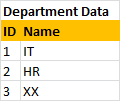Suggested Videos
Part 20 - Element Operators in LINQ
Part 21 - Group Join in LINQ
Part 22 - Inner Join in LINQ
In this video, we will discuss the difference between Group Join and Inner Join in LINQ with examples. We will be using the following Department and Employee classes in this video.
Department data returned by GetAllDepartments() method is shown below

Employee data returned by GetAllEmployees() method is shown below

The following query performs a GroupJoin on the 2 lists
Notice that we are using the join operator and the into keyword to group the results of the join. To perform group join using extension method syntax, we use GroupJoin() Extension method as shown below.
The above 2 queries groups employees by department and would produce the following groups.

To print the Department and Employee Names we use 2 foreach loops as shown below.
The following query performs an Inner Join on the 2 lists
To perform an inner join using extension method syntax, we use Join() Extension method as shown below.
The above 2 queries would produce a flat result set as shown below

To print the Department and Employee Names we use just 1 foreach loop as shown below.
In short, Join is similar to INNER JOIN in SQL and GroupJoin is similar to OUTER JOIN in SQL

Part 20 - Element Operators in LINQ
Part 21 - Group Join in LINQ
Part 22 - Inner Join in LINQ
In this video, we will discuss the difference between Group Join and Inner Join in LINQ with examples. We will be using the following Department and Employee classes in this video.
public class Department
{
public int ID
{ get; set;
}
public string Name
{ get; set;
}
public static List<Department> GetAllDepartments()
{
return new List<Department>()
{
new Department { ID = 1, Name = "IT"},
new Department { ID = 2, Name = "HR"},
new Department { ID = 3, Name = "XX"},
};
}
}
public class Employee
{
public int ID
{ get; set;
}
public string Name
{ get; set;
}
public int DepartmentID
{ get; set;
}
public static List<Employee> GetAllEmployees()
{
return new List<Employee>()
{
new Employee { ID = 1, Name = "Mark", DepartmentID = 1
},
new Employee { ID = 2, Name = "Steve", DepartmentID =
2 },
new Employee { ID = 3, Name = "Ben", DepartmentID = 1
},
new Employee { ID = 4, Name = "Philip", DepartmentID =
1 },
new Employee { ID = 5, Name = "Mary", DepartmentID = 2
}
};
}
}
Department data returned by GetAllDepartments() method is shown below

Employee data returned by GetAllEmployees() method is shown below

The following query performs a GroupJoin on the 2 lists
var result = from
d in Department.GetAllDepartments()
join e in
Employee.GetAllEmployees()
on d.ID equals e.DepartmentID into eGroup
select new
{
Department = d,
Employees = eGroup
};
Notice that we are using the join operator and the into keyword to group the results of the join. To perform group join using extension method syntax, we use GroupJoin() Extension method as shown below.
var result = Department.GetAllDepartments()
.GroupJoin(Employee.GetAllEmployees(),
d => d.ID,
e => e.DepartmentID,
(department, employees) =>
new
{
Department = department,
Employees = employees
});
The above 2 queries groups employees by department and would produce the following groups.

To print the Department and Employee Names we use 2 foreach loops as shown below.
foreach (var department in result)
{
Console.WriteLine(department.Department.Name);
foreach (var employee
in department.Employees)
{
Console.WriteLine("
" + employee.Name);
}
Console.WriteLine();
}
The following query performs an Inner Join on the 2 lists
var result = from
e in Employee.GetAllEmployees()
join d in
Department.GetAllDepartments()
on e.DepartmentID equals d.ID
select new { e, d };
To perform an inner join using extension method syntax, we use Join() Extension method as shown below.
var result = Employee.GetAllEmployees()
.Join(Department.GetAllDepartments(),
e => e.DepartmentID,
d => d.ID, (employee,
department) => new
{
e = employee,
d = department
});
The above 2 queries would produce a flat result set as shown below

To print the Department and Employee Names we use just 1 foreach loop as shown below.
foreach (var employee in result)
{
Console.WriteLine(employee.e.Name + "\t" + employee.d.Name);
}
In short, Join is similar to INNER JOIN in SQL and GroupJoin is similar to OUTER JOIN in SQL

No comments:
Post a Comment
It would be great if you can help share these free resources